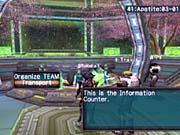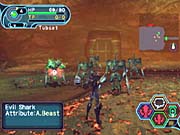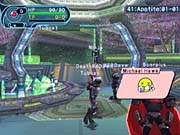Sonic Team's Phantasy Star Online series has made the rounds to just about every single console, yet every release has seen some sort of addition in the form of extra levels or character classes. The Xbox version of Phantasy Star Online Episode I & II is no different. Though there isn't really any new content, this version of the game possesses one thing that was sorely lacking in its GameCube counterpart--a form of communication that's just as simple to use as the game's built-in symbol chat and less cumbersome than holding a keyboard in your lap. Thanks to the Xbox Live service, Phantasy Star Online Episode I & II supports voice communication, making it incredibly easy to chat with other players in the lobby or devise strategies with three other players in an online game while plowing through the game's many dungeons. It makes the entire experience of playing the game online much more personable and consequently more entertaining.

Phantasy Star Online Episode I & II offers the same three character classes as the original game: hunter, ranger, and force. There's also an additional character type for each class that features slightly different attributes from other characters in that class. For example, most characters in the hunter class are proficient with swords and can use other weapons, including some of the less-accurate long-range weapons, and some can also use magic. The new female android hunter introduced in Episode I & II, however, can't use magic at all, but because of her metallic body, she's immune to poison attacks, whereas other hunters are not.
There are similar advantages and disadvantages to using characters in the other classes, as well. The rangers use guns as their primary weapons and can use all the rifles and other specialized long-range weapons in the game, but they have only a limited ability to use melee weapons. In the original game, only one character in the ranger class had magic capabilities, but in Episode I & II there's another character who can use a variety of offensive spells to offset her inherently weak strength. The force class is made up of magic users who can't use some of the stronger weapons and who are generally weaker than any other characters. The new character added to the force class is for hard-core magic users and is incredibly difficult to use in the early levels simply because of his low defensive capabilities. It's also worth noting that new players should level their characters up in Episode I before attempting to take on Episode II, because of its higher difficulty.

The characters in Phantasy Star Online Episode I & II are pretty well balanced, which encourages you to have a healthy mix of classes in your online party or in the offline split-screen multiplayer mode--at least during boss battles and in the later stages of the game. In the earlier levels, you'll notice that the long-range-weapon users (the hunters and rangers in particular) have an advantage over melee characters simply because enemies can't walk through entryways. This allows for the strategy of walking into a room, firing a few shots at an enemy, walking back outside the room, and then repeating the process until all the enemies in the room are dead. If you're a melee character, fighting in close quarters puts you at risk of being counterattacked by an enemy and then being trapped by a group of foes. When that happens, you better hope someone in your party has the ability to resurrect your character, or you're going to head back to the Pioneer--the equivalent of a home base, where you can buy weapons, armor, or items. You don't lose any of these items when you die, though you do lose money. You can also use the Pioneer as a safe area to feed your mag. A mag is somewhat like a virtual pet, and it gives you bonuses in different attributes. The mags can become stronger and change in physical appearance after being fed certain types of items, which will determine what sort of special attack the mags can unleash when their energy meters are full.
Those just learning to use Phantasy Star Online's combat system may be seeing the Pioneer quite often, because there's a small learning curve for using the system effectively. Regular weapons have two attacks--regular and strong--while unique weapons have both of these attacks and a special attack. To launch a combination of any three attacks, you have to properly time them, which can be a little difficult initially, and it can be made even more complicated by the game's relatively poor targeting system. Instead of letting you manually lock on to an enemy, the game automatically decides what to lock on to, which is usually the object within your direct line of sight, whether it's a treasure box or an enemy. As you might suspect, this becomes problematic when engaging a group, because the game won't necessarily target the nearest enemy, thus allowing that enemy to slip by and attack. In addition, you'll occasionally find yourself struggling with the camera to adjust your line of sight so you can target a specific enemy.
Thankfully, if you're playing the game on Xbox Live, you can always just tell your teammates that you're in trouble and need some help. Of course, this also pretty much negates the usefulness of symbol chat, a system that allows you to edit and create basic images and shapes to indicate a certain problem, such as a need for a health item. Indeed, symbol chat has become somewhat of an added customization feature in the game, allowing you to create something that will make your character stand out from the packs of people playing the game. In addition, voice communication has completely removed the need for a built-in software keyboard or even an actual keyboard, although Microsoft is offering an attachment that lets you use a keyboard for the game. But in any case, voice communication is a welcome feature that helps enhance the community aspect of the game and cures most of the GameCube version's shortcomings in that particular area.

Phantasy Star Online Episode I & II supports up to four players on a split screen, but it's not quite the same as playing the game online. Perhaps the most noticeable difference between the two options is death. In split-screen mode, when one character dies, it can either stay dead and let the other characters in the game continue or it can go back to the Pioneer, but if the character does go back to the Pioneer, then all the other characters automatically go back as well, since Sonic Team apparently couldn't find a way to render completely different environments within each split-screen window. The camera also seems to become worse in the split-screen mode. For example, during one of the boss battles, the camera is always panned upward, which prevents you from seeing any items or hazards that might be on the ground. You'll also struggle with the camera while maneuvering through tight corridors, though in some cases you can move the camera out of a bad area.
You can also participate in some of the alternative modes, such as challenge and battle, in the single-player game. The challenge mode gives participants random statistics and weapons and then places them in a level from the game where they have to struggle to stay alive as long as possible. The battle mode is essentially the same as the regular multiplayer mode, but it lets players attack each other, so it can essentially be used as a means for dueling. Interestingly, a character's dueling win-loss record can be displayed over his or her head while walking through the lobby, so you can see what kind of opponent you're going up against.
The online mode seems to be pretty stable at this point, with only a few slight synching problems, such as characters not appearing in the proper area. There are already quite a few players online, so you shouldn't have trouble finding a game, whether it's Episode I or Episode II. Though, it's certainly worth pointing out that there's no mention of an additional fee for playing Phantasy Start Online Episode I & II online on the front of the box, but there's a small mention of it in the game's woefully small manual and in the game itself when you're purchasing a hunter's license. After a free two-month trial period, the game will automatically bill $8.95 a month to the credit card you used when signing up for Xbox Live. In another strange twist, the game requires you to have a valid Xbox Live account to play the game at all, online or off.
Phantasy Star Online's visuals probably won't be enough to entice anyone to overlook the subscription fee, especially considering that the Episode I levels look nearly identical to their Dreamcast counterparts, except for a few slight enhancements to the special effects. The first two environments in Episode II aren't all that detailed, but when you see the later levels, you'll be wondering if you're playing the same game. Instead of being simplistic rectangular environments, the later levels in Episode II are much more free-flowing and natural, with an enormous amount of detail and plenty of spectacular visual effects, including some incredible-looking water and lighting. The jungle level in particular has a few visually spectacular moments, most notably a series of pools of water on top of a cliff overlooking the ocean. The frame rate remains fairly constant throughout most of the game, but it tends to take a nosedive during some of the multiplayer boss battles, such as the Episode II dragon fight. This can make it difficult to play the game, since targeting is based on movement. Overall, the game doesn't exactly push the limits of the Xbox hardware, and it's unfortunate that Sonic Team didn't take the time to enhance some of the special effects or other graphical features in the game, outside of including 480p support for HDTVs, which doesn't really make the game look much better.

Like in the original game, the music isn't particularly memorable, and in some cases it plays an ambient role. Interestingly, none of the tracks seem to become annoying, even though you have to listen to them repeatedly. The game's sound effects are just fine, and those with good sound equipment will be happy to know that the game supports Dolby 5.1 audio.
If you passed on the GameCube version of Phantasy Star Online Episode I & II because of the lack of domestic keyboard support, then the Xbox version might be a worthwhile proposition. But keep in mind that if you've already played the Dreamcast incarnations of the Phantasy Star Online series, you'll have less incentive to check out what Episode I & II has to offer, simply because much of the content is identical. Of course, if you've already played through the GameCube version, there really is no reason to play through the Xbox version. However, if you're completely new to the Phantasy Star Online experience and you're willing to pay the fees for online play, then you'll find an incredibly addictive game that will keep you glued to the TV for hours on end.